Jan 18, 2018
New York’s silly climate suit
By Steve Goreham - - Sunday, January 14, 2018
ANALYSIS/OPINION:
On January 10, the city of New York filed suit against BP, Chevron, Conoco-Phillips, ExxonMobil and Royal Dutch Shell. The suit accuses oil companies of causing dangerous climate change and damage to New York City, seeking monetary compensation. But history will rank this action high in the annals of human superstition.
The 67-page suit claims that burning of fossil fuels marketed by the oil industry changes the climate and that these changes are “injuring New York City.” The suit projects an increase in deaths from heat waves, flooding from extreme weather that would impact the city’s water supply system, increasing frequency of droughts that would diminish water to upstate New York reservoirs, and catastrophic flooding from rising oceans.
Hurricane Sandy is mentioned several times in the suit as an example of both extreme weather and rising oceans from human-caused warming. As a result of Sandy, New York launched a $20 billion effort to prepare for the effects of climate change in 2017. The city wants oil firms to pay for this effort, claiming they are causing “continuous and reoccurring injuries to the city. But these claims border on the superstitious.
Hurricane Sandy hit New Jersey and New York City on October 29, 2012 with Category 1 hurricane-force winds of 81 miles per hour. It came ashore at high tide causing extensive flooding. The storm resulted in 147 and over $50 billion in assessed damage. But this has happened before.
More than 80 tropical or sub-tropical storms struck New York State during the last 300 years. An example was the Norfolk and Long Island Hurricane of 1821. It hit New York City with Category 3 force winds, much stronger than Category 1 Sandy. Although it came ashore at low tide, when ocean levels were five feet lower than when Sandy hit, the 1821 storm flooded New York City up to Canal Street.
According to the National Hurricane Center, 170 hurricanes made US landfall during the twentieth century. Fifty-nine of these storms generated at least Category 3 wind speeds, stronger than Category 1 Sandy. How then was Hurricane Sandy evidence of human-caused global warming?
Ocean levels have risen about 120 meters (390 feet) in the last 20,000 years, according to data from NASA. Tidal gauges show a rise of about 7 inches per century over the last 150 years. No scientist can tell us when natural sea level rise stopped and man-made sea level rise began. New York City is correct to prepare for rising seas, but wrong to believe that greenhouse gases from burning oil are causing the rise.
Throughout history, people have believed that human actions can change the climate and cause extreme weather. The Aztecs of the 1500s practiced human sacrifice in an attempt to control the weather and to keep the Sun moving across the sky. After King Henry divorced his wife, Catherine, in 1533, the English believed that nine months of unusually heavy rainfall were a result of the divorce. During the cool climate of the Little Ice Age between the fourteenth and nineteen centuries, hundreds of thousands of people in Europe were executed for the crime of witchcraft, blamed for short growing seasons and crop failures.
Today we still live in a world of superstition. Climate advocates tell us that if we change our light bulbs we can save polar bears. If we erect wind turbines we can make the storms less severe. And if we drive electric cars we can stop the oceans from rising. Our modern witches are the oil and coal companies.
Steve Goreham is the author of “Outside the Green Box: Rethinking Sustainable Development” (New Lenox Books, 2017).
Jan 12, 2018
Sydney Heat and “Bomb” Snowstorm: Pimped Out for Climate Change
Update: Uber wealthy economic summit goers getting testy at Davos after 6 feet of snow in a few days.
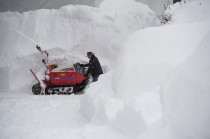
See this NYT story.
---------------
Dr. Roy Spencer
January 7th, 2018
It’s been an eventful weather week in some portions of the globe. In fact, it is always an eventful weather week - somewhere.
But what really drives the narrative is when weather extremes - which always have, and always will, occur - happen to hit major metropolitan areas. Many people are already aware of the relentless guffawing resulting from Al Gore’s tweet that Michael Mann says the Northeast’s current cold wave is just what global warming predicts. (As I recall, Mann is a mathematician, not a meteorologist. Correction: Mann is a geologist/geophysicist, which is equally uninformed on atmospheric dynamics.)
Yesterday, Kristine Phillips of The Washington Post wrote about the recent “bomb” snowstorm in New England, the ensuing cold wave, and the extreme heat (110+ deg. F) that has just hit Sydney, Australia.
To her credit, she did not explicitly put the blame on climate change for these events, but her legal-background prose came pretty darn close… just close enough so that the casual reader would make the connection. Wink-wink, nod-nod.
The trouble is that neither of these two events are exceptional from a meteorological perspective. That is, they have happened before (Sydney’s 117 deg. F peak was exceeded in 1939), and they will happen again.
It is only when we can demonstrate that such events are increasingly occurring over, say, 50 to 100 years that we can begin to invoke climate change. (And even then we must debate the various causes of climate change.) So far, that evidence is sorely lacking.
The Sydney Heat Wave
Here’s the GFS forecast model analysis of surface temperature departures from average for about the time that peak temperatures were reached in Sydney yesterday. Maybe you can tell me which of these cold and warm patterns are consistent with global warming theory and which aren’t? (Hint: Warming should be occurring basically everywhere):
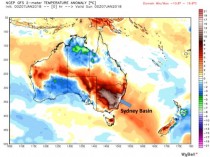
GFS analysis of surface temperature departures from normal at about the time 110 deg. F temperatures were reached in Sydney, Australia (Weatherbell.com graphic).
See that hotspot in the Sydney Basin? That is a localized effect of downslope winds from the highlands to the west which causes enhanced warming of the air, as well as bushfires. It clearly does not represent what is happening across Australia as a whole. Australia is exceedingly hot this time of year anyway, heat which is made even worse since the sun is closer to the Earth in January than in July (leading to a 7% range in solar radiation reaching the Earth).
The “Bomb” Blizzard
Meteorologist Fred Sanders coined the term “bomb” in 1980 to refer to a non-tropical cyclone whose central pressure drops by at least 24 millibars in 24 hours.
They happen every year.
But what doesn’t happen every year is them influencing major metro areas. So, the recent nor’easter snowstorm to hit the Mid Atlantic and New England was also a “bomb” because the low pressure center intensified so rapidly. These events happen every year in, for example, the North Atlantic and North Pacific.
We meteorologists used to talk about “bombs” fairly regularly in the 1980s, but not so much in recent years. I wonder if maybe climate change is making winter storms weaker? Hmmm…
And to attribute every winter cold wave or heat wave to global warming is just plain silly. These things happen even without global warming (which, by the way, I do believe is occurring, just not very strongly, dangerously, or maybe not even mostly due to human causation). Seasoned New Englanders can tell you that.
Meanwhile, The Weather Channel (aka “The Disaster Channel") serves up a steady stream of weather porn to titillate the senses.
And before you believe that warmth in January is unusual, “January thaws” are a routine phenomenon, too, which is why the term was coined. According to the Glossary of Meteorology:
“The daily temperature averages at Boston, computed for the years 1873 to 1952, show a well- marked peak on 20-23 January; the same peak occurs in the daily temperatures of Washington, D.C., and New York City. Statistical tests show a high probability that it is a real singularity. The January thaw is associated with the frequent occurrence on the above-mentioned dates of southerly winds on the back side of an anticyclone off the southeastern United States.”
Nevertheless, the weird-weather-is-climate-change narrative will continue until the populace finally agrees with the warmongers that we can control our weather through taxation and regulation.
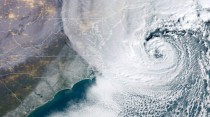
Da Bomb January 4th, 2018
GOES-16 image of the intense extra-tropical cyclone at 8:45 EST January 4, 2018.
The rapidly intensifying non-tropical cyclone producing heavy snow and blizzard conditions over the mid-Atlantic and New England is meeting expectations, with localized snowfalls of over 6 inches already this morning.
The latest NAM model forecast of additional snowfall after 7 a.m. this morning until tomorrow morning shows up to 12-18 inches of snow over portions of Massachusetts, Connecticut, Rhode Island, Vermont, and Maine (graphic courtesy of Weatherbell.com):
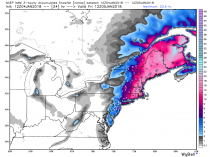
Maximum additional snow accumulations from 7 a.m. Thursday Jan. 4 to 7 a.m. Friday, from the NAM weather forecast model.
As of 9 a.m. EST, all 5 NWS reporting stations in Rhode Island have heavy snow falling.
The term “bomb” was coined by meteorologist Fred Sanders in 1980 to refer to a non-tropical low pressure area that intensifies at least 24 millibars in 24 hours. They happen every year, and are usually centered offshore in the winter where cold continental air masses meet warm oceanic air masses, providing maximum energy to the intensification process.
Jan 05, 2018
What Cannabis Growers Know that Climate Scientists Don’t Know
By Steve Goreham
On November 3, the U.S. Global Change Research Program released the “Fourth National Climate Assessment,” a 477-page document filled with concern about Earth’s changing climate. The study concluded that human emissions of carbon dioxide (CO2) cause dangerous global warming. But marijuana growers know something that climate scientists apparently don’t know.
The Fourth Assessment is an alarming document that uses the word “extreme” more than 700 times to describe storms, floods, droughts, precipitation, snowfall, temperature and other weather variations. The Assessment concludes: “Reducing net emissions of CO2 is necessary to limit near-term climate change and long-term warming.” Essentially, the report concludes that CO2 emissions are dangerous.
While the Assessment doesn’t call CO2 “pollution,” other parties use the report to do so. The American Academy of Sciences states that the Assessment “reinforces that warming temperatures and extreme weather” are “the result of carbon pollution from human activities.” The Atlantic says that the Assessment confirms that “Climate Change is real. It’s caused by greenhouse gas pollution released by human industrial activity.”
But marijuana growers know that carbon dioxide isn’t pollution. It’s plant food! Any smart cannabis grower pumps carbon dioxide into the greenhouse to make the pot crop grow bigger and faster. Marijuana growers use canisters of CO2 gas and CO2 generators hang from greenhouse rafters to boost crop yields.
Hundreds of peer-reviewed studies show that plants grow bigger with higher levels of atmospheric carbon dioxide. In 2011, Dr. Craig Idso, founder of the Center for the Study of Carbon Dioxide and Global Change, compiled the results of more than 1,000 scientific papers reporting on CO2 enrichment experiments. He developed estimates of the mean crop growth rate in response to a 300-ppm increase in the level of atmospheric CO2. The data shows that all 92 of the world’s food crops grew larger with increased levels of carbon dioxide. The world’s seven largest food crops, corn, potato, rice, soybean, sugar beet, sugar cane, and wheat, grew between 21 and 66 percent larger in controlled experiments.
Plants get bigger fruits and vegetables, thicker stems, and larger root systems with higher levels of atmospheric carbon dioxide. Higher levels of CO2 also make plants more resistant to drought.
The recent rise in atmospheric CO2 that climate scientists fret about is actually greening the Earth. A 2013 study led by Dr. Randall Donahue of Australia’s Commonwealth Scientific and Industrial Research Organization analyzed plant growth using satellite data. After accounting for changes in precipitation, the study found an eleven percent increase in global leaf area from 1982 to 2010. Most of this increase was attributed to rising levels of atmospheric carbon dioxide.
Rather than a negative, rising levels of atmospheric CO2 must be boosting global agricultural output. If there is one compound that humans can put into nature that is great for the biosphere, carbon dioxide is that compound. But today carbon dioxide is branded “pollution” and every company and every university foolishly tries to reduce CO2 emissions.
Steve Goreham is a speaker on the environment, business and public policy and author of the new book ‘Outside the Green Box: Rethinking Sustainable Development.’
-----------
Back in January 2014, I wrote this story:
Superbowl, Cannabis and CO2
By Joseph D’Aleo, CCM
The two surviving teams going to the superbowls coming from the two states that have legalized marijuana. I will avoid speculating a possible role of that in bringing that outcome, I will make the point that they can thank CO2 for increasing photosynthesis, limiting the transpiration (moisture loss through pores on the leaves) and through that significantly limiting the water usage needs for Cannibas.

A paper supported by the National Institute for Health (NIH) published in Physiol. Mol. Biol. Plants, 14(4) October, 2008, Photosynthetic response of Cannabis sativa L. to variations in photosynthetic photon flux densities, temperature and CO2 conditions by Suman Chandra, Hemant Lata, Ikhlas A. Khan and Mahmoud A. Elsohly tells us the story. From the abstract we see:
Effect of different photosynthetic photon flux densities (0, 500, 1000, 1500 and 2000 μmol m-2s-1), temperatures (20, 25, 30, 35 and 40 degrees C) and CO2 concentrations (250, 350, 450, 550, 650 and 750 μmol mol-1) on gas and water vapour exchange characteristics of Cannabis sativa L. were studied to determine the suitable and efficient environmental conditions for its indoor mass cultivation for pharmaceutical uses.
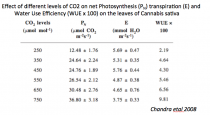
Enlarged
An average of 30 to 33 % increase in PN photosynthesis productivity of C3 plants with doubling atmospheric CO2 concentration has been already reported by Kimball 1983a, b; 1986; Idso and Idso 1994; Bazzaz and Gabutt, 1988; Cure and Acock, 1986. In Cannibas sativa, a doubling of CO2 concentration (750 μmol mol-1) suppressed E 29 % stimulated PN by 50% as compared to ambient CO2 concentration. Doubling CO2 level had a significant effect on all these parameters.
We may gain more converts into the battle against the cabonistas if we educate the public in these blue green states on this fact!!!!

Puts a new light on Arte Johnson’s character from Laugh-In. Very interesting.
Dec 19, 2017
Trump Cuts Climate Change, Sets National Health Priorities
Jane M. Orient, MD
Update: See also this from the Manhattan Contrarian by Francis Menton on this issue here.
The Trump Administration has announced the removal of climate change from the list of national security threats. This Obama Administration priority was responsible for policies such as trying to make the U.S. Navy a ‘Great Green Fleet’ running on “advanced biofuels.” The rationale was that global warming (renamed “climate change") was a bigger threat than terrorist attacks or North Korean nuclear-tipped intercontinental ballistic missiles, and that running aircraft carriers on a blend of 90 percent diesel and a very costly additive made from beef fat or palm oil would somehow protect against bad weather over the next century.
Climate change is also supposed to be the greatest global health threat, according to a consortium of medical organizations and Pope Francis, who oppose President Trump’s decision to withdraw from the Paris climate agreement. The predicted climate disruption is evidently worse than poverty, AIDS, poor sanitation, Ebola, or other emerging infectious diseases, in their opinion. It is, indeed, supposed to worsen those factors, for example by increasing the range of insect vectors like mosquitoes. (Never mind that mosquitoes thrive in Alaska and Siberia.)
Fifty years of public health gains could be reversed, warn 22 authors in the prestigious British journal The Lancet, if we don’t take urgent action to limit emissions of carbon dioxide from the fuels that now power 80 percent of the world’s economy (coal, oil, and natural gas - “fossil fuels"). The “planet still has time to heal,” they say, but we are on a “countdown.”
It’s a little hard to get the public aroused about heat waves 50 years from now, while people are shoveling “heart attack snow,” or trying to keep from freezing to death. Deaths from cold are historically far more prevalent than deaths from heat waves. Arctic cold is setting dozens of records for low temperatures in the U.S. Northeast, and a Siberian cold front has already killed dozens in Central and Eastern Europe, with 50-year record lows as far south as Bulgaria.
European countries such as England and Germany that are taking the lead on turning to “renewables” - the German Energiewende - prices for fuel and electricity have soared. Many people have to choose whether to “heat or eat.”
It takes an apocalyptic threat to get people to accept economic hardship. The UN’s Intergovernmental Panel on Climate Change (IPCC) and prominent U.S. academics constantly trumpet a litany of horribles that will supposedly be inevitable without drastic, immediate changes. California and other jurisdictions claim that they will take unilateral action to “protect” or “stabilize” earth’s climate despite Trump’s opposition. Dozens of Congressmen of both parties have joined the Climate Solutions Caucus to oppose Trump.
President Trump’s priority is energy security - or energy dominance for America. His initiatives include:
Removing climate alarmism messages from official government websites;
Cutting the funding of the multi-billion dollar infrastructure devoted to “finding” human-caused climate change and promoting an agenda of global energy rationing;
Demanding that the Environmental Protection Agency (EPA) include all scientific viewpoints instead of silencing critics of the “sky is falling’ narrative; and Rolling back Obama regulations and policies designed to kill the coal industry and suppress use of America’s petroleum and natural gas resources.
The world’s greatest killer is poverty. Prosperity depends on adequate, reliable, affordable energy. Income rises with increased use of hydrocarbons (and CO2 emissions), and life expectancy rises with income.
But perhaps even more important to public health than energy is scientific integrity. Trump is basically at odds with the self-anointed scientific authorities who demand that their computer models be accepted as gospel and used to impose trillions of dollars in costs. This authoritarianism garbed in science is in itself a disaster. Moreover, the models give wrong answers, and the policy recommendations are all pain for no gain. To demonstrate this, Doctors for Disaster Preparedness posed 10 Climate Change IQ Questions to the Climate Solutions Caucus, inviting them to seek a refutation from their go-to experts. So far, not a single argument has been presented.
President Trump’s initiatives on energy and climate challenge medical and public health authorities to prove their anti-carbon case, instead of just imposing it on the world. That is both a national security and a health priority.
Jane M. Orient, M.D. is executive director of the Association of American Physicians and Surgeons. She also is president of Doctors for Disaster Preparedness, and is the editor of AAPS News, the Doctors for Disaster Preparedness Newsletter, and Civil Defense Perspectives. She is the managing editor of the Journal of American Physicians and Surgeons.
Dec 10, 2017
Wildfires are a natural part of nature though bad policies make the results worse
Wildfires have been in the news almost every late summer and fall. Every year, the media blames ‘climate change’. Governor Brown says these Raging Wildfires are “The New Normal,” for which he Blames Climate Change. The truth is the fires are normal and the damage done is greater because more people want to escape the urban areas and live in the hills among the trees. Ironically, government policies driven by extreme environmentalists like Governor Brown are making the fires worse. See more here.
This month, fires have spread to the Los Angeles region as strong Santa Ana winds and dry air caused the fire to spread rapidly.
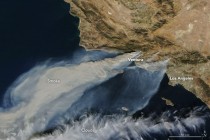
Enlarged
Earlier in the fall, the wildfires that swept through California in October of 2017 burned 200,000 acres and destroyed or damaged more than 5,500 homes. It was widely reported these fires were the worst and most extensive and deadly ever. And, it was widely reported that these fires were greatly worsened by Global Warming.
Actually, the number of fires and acreage affected since 1985 show the number of fires is actually down slightly though the acreage burned had increased before leveling off the last 20 years. The NWS tracks the number of days where conditions are conducive to wildfires when they issue red-flag warnings. It is little changed.
When it comes to considering the number of deaths and structures destroyed, the seven-fold increase in population in California from 1930 to 2017 must be noted. Not only does this increase in population mean more people and home structures in the path of fires, but it also means more fires. Lightning and campfires caused most historic fires; today most are the result of power lines igniting trees. The power lines have increased proportionately with the population, so it can be reasoned that most of the damage from wild fires in California is a result of increased population not Global Warming. The increased danger is also greatly aggravated by poor government forest management choices.
Large-scale deadly fires are not unique in the nation’s history.
“In 1871, during the week of Oct. 8-14, it must have seemed like the whole world was ablaze for residents of the Upper Midwest. Four of the worst fires in U.S. history all broke out in the same week across the region. The Great Chicago Fire, which destroyed about a third of the city’s valuation at the time and left more than 100,000 residents homeless, stole the headlines.
But at the same time, three other fires also scorched the region. Blazes leveled the Michigan cities of Holland and Manistee in what has been referred to as the Great Michigan Fire, while across the state another fire destroyed the city of Port Huron. The worst fire of them all, however, might have been the Great Peshtigo Fire, a firestorm that ravaged the Wisconsin countryside, leaving more than 1,500 dead - the most fatalities by fire in U.S. history.” Link.
Weather and normal seasonal and year-to-year variations brings fires to the west every year and other areas from time to time. This past winter was a very wet one, and in the mountains in the west, a snowy one. Wet winters cause more spring growth that will dry up in the dry summer heat season and become tinder for late summer and early fall fires before the seasonal rains return.
The number of fires and acreage affected since 1985 show the number of fires is actually down slightly though the acreage burned had increased before leveling off the last 20 years. The NWS tracks the number of days where conditions are conducive to wildfires when they issue red-flag warnings. It is little changed.
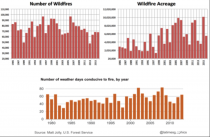
Enlarged
ROLE OF DEVELOPMENT AND GOVERNMENT POLICIES
People find it desirable to live in the quiet beauty of the hilly wooded developments away from the big cities-- unfortunately in areas that are vulnerable to wildfires when the strong seasonal winds blow at the end of the dry season.
The danger is aggravated by bad environmental and governmental policies. Last summer, Governor Brown vetoed a bi-partisan bill to help subsidize PGE tree removal from near power lines and transformers as the law requires. The downed trees and power lines/transformers are believed to be the cause of at least some of the fires as the sparks ignited the dry brush and the cinders and sparks are carried by the same winds that brought down the lines and transformers.
The National Park Service changed its policy in 1968 to recognize fire as a natural ecological process. Fires on federal lands were to be allowed to run their courses where possible.
In a May, 2017 congressional hearing, Rep. Tom McClintock, R-Calif., said, “Forty-five years ago, we began imposing laws that have made the management of our forests all but impossible.” “Time and again, we see vivid boundaries between the young, healthy, growing forests managed by state, local, and private landholders, and the choked, dying, or burned federal forests’”
McClintock said. “The laws of the past 45 years have not only failed to protect the forest environment - they have done immeasurable harm to our forests.” In an October, 2017 House address, McClintock pinned the blame of poor forest management on bad 1970s laws, like the National Environmental Policy Act and the Endangered Species Act. He said these laws “have resulted in endlessly time-consuming and cost-prohibitive restrictions and requirements that have made the scientific management of our forests virtually impossible.”
Interior Secretary Ryan Zinke has promoted a change to forest management policies, calling for a more aggressive approach to reduce the excess vegetation that has made the fires worse. See more.
Ironically if CO2 has played a role, as a fertilizer, it has increased the greening in wet water years like 2016/17.
See Cliff Mass rebut the claims that the CO2 is driving increasing wildfires.
|











